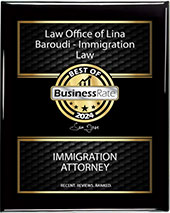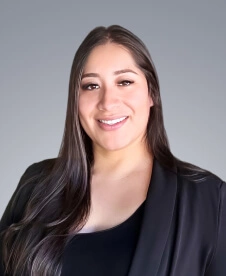So you met and married the love of your life, and now you want to bring them to the U.S.? You probably have a lot of questions about visas and immigration.
Spousal visas grant the partners of U.S. citizens and permanent residents the legal right to immigrate and build a life together. For countless couples separated by borders, they represent the only ticket to permanently closing the distance.
But the process comes with stringent eligibility standards, demanding application requirements, and lengthy processing times that can deter even the most committed couples.
At the Law Office of Lina Baroudi in San Jose, our spousal visa lawyers guide you through the process – from proving relationship legitimacy to navigating the paperwork, interviews, and waits.
CR-1 and IR-1 — The Two Types of Spousal Visas
A spousal visa allows an American citizen or permanent resident to sponsor their husband, wife, or spouse so they can immigrate to the United States.
The two types of spousal visas are the IR-1 for spouses married for two or more years and the CR-1 for those married for less than two years at the time that they become green card holders.
Either way, a spousal visa lets your spouse live and work here permanently. And, with either spousal visa, the immigrant spouse becomes a permanent resident as soon as they arrive in the U.S.
How Much Do Spousal Visas Cost?
The total cost of obtaining a spousal visa can vary greatly, but the main expenses include:
- Filing Form I-130 petition: $535
- Immigrant visa application (DS-260): $325
- Affidavit of Support fee: $120
- Green card processing fee: $220
- Medical exam fees: Ranges from $48 to $275+ depending on country
- Document expenses: Costs for translations, passports, birth certificates, photocopies, etc.
- Related travel costs: For required interviews, medical exams, etc.
Additional future costs for those with a conditional permanent resident (CR1) visa:
- Filing Form I-751 to remove conditions: $595
- Biometrics fee: $85
So, in total, applicants can expect to pay at minimum around $1200-1500 in government fees and medical costs. Factoring in travel, documentation, translations, and legal assistance, the total cost for obtaining a marriage-based spousal visa often runs between $2000 and $3000+.
The process is certainly not cheap. But for many married couples faced with indefinite separation, the expense is worth it to finally close the distance and live together permanently.
Spousal Visa Application Process (Consular Processing)
Applying for a spousal visa involves both USCIS and the Department of State, so the process has quite a few moving parts.
Here are a few key steps:
- Confirm eligibility – Make sure you meet all requirements like being in a legitimate marriage, your spouse is a U.S. citizen or permanent resident, etc.
- File Form I-130 – The sponsoring spouse completes this “Petition for Alien Relative” and submits it to USCIS.
- Wait for approval – It can take anywhere from 2 months to over a year for USCIS to process and approve Form I-130.
- Check Visa Bulletin – Once your I-130 is approved, check the Visa Bulletin to see if a green card is currently available based on your country and visa category, if applicable. Spouses of U.S. citizens are “immediate relatives,” so they will skip this step.
- National Visa Center processing – Your petition gets forwarded to the NVC, which will create your case, collect fees, and instruct you to complete Form DS-260.
- Submit Form DS-260 – This is the actual immigrant visa application with personal details, background, and work/education history that you must complete.
- Interview scheduled – The embassy/consulate contacts you to schedule a date and time for your visa interview.
- Get a medical exam – Before the interview, you must complete a medical exam with an approved doctor listed by the embassy.
- Attend interview – Bring all required documents and answer questions about your application under oath.
- Receive decision – You will hear back on your application usually within one week, either approved, refused, or requiring further inquiry (called “administrative processing.”)
- Get a visa and travel – If approved, you are issued a visa to enter the U.S., usually with a validity of six months. You must enter the U.S. before the expiration of your immigrant visa.
This consular processing pathway outlines the main steps to get a marriage-based spousal visa for immigrant spouses outside the U.S. Those already in the U.S. usually apply through the adjustment of status process if they meet all of the eligibility requirements.
How Long Does It Take to Get a Spousal Visa?
The total timeline varies but is currently 18 months or a year and a half. Factors like processing delays or consulate/embassy backlogs play a large part in how long each individual’s case may take. We recommend staying patient and keeping all your paperwork organized so you can stay on top of each step.
Can LGBTQ+ Couples Apply for a Spousal Visa?
Yes! Same-sex and transgender spouses of U.S. citizens and permanent residents have equal eligibility to apply for spousal visas, with the same e application process and requirements outlined above.
The Supreme Court’s 2013 Windsor v. United States decision was a landmark victory for same-sex immigration rights. It overturned the Defense of Marriage Act provision that denied federal marriage benefits to legally married same-sex couples.
This ruling enabled immigration equality by allowing thousands of bi-national same-sex couples to permanently live together in the United States.
Importantly, if an LGBTQ+ spouse does not feel safe applying for a spousal visa in their home country, there are options to request processing at an embassy or consulate in another country.
Lina Baroudi is a compassionate LGBTQ+ immigration lawyer and is here to guide you through the process.
Life After the Spousal Visa — What Happens Next?
Once you have successfully obtained a spousal visa, you can finally immigrate to the U.S. to live with your spouse permanently.
If you were married for less than two years at the time your visa was approved, you will receive conditional permanent resident status (CR1 visa). This requires you to apply again to remove conditions after two years.
If you were married for more than two years when approved, you get full permanent resident status (IR1 visa) and only need to renew your green card every ten years.
Those with a CR1 visa must take these next steps:
- Enter the U.S. within six months of receiving the visa (or before the expiration date on the visa), or it will expire.
- Apply to remove visa conditions within 90 days before the 2-year anniversary of arriving in the U.S. Use Form I-751.
- Prove your marriage is still legitimate with evidence like:
– Joint bank account statements
– Children’s birth certificates
– Shared property records and deeds
– Photos spanning the two years - Attend biometrics appointment and interview (if scheduled).
- If approved, conditions are removed, and you gain a full 10-year green card.
Spousal visas allow married immigrants to permanently work, live, and build a life with their U.S. citizen or permanent resident spouse. While extra steps exist for those with conditional status, ultimately, the immigrant visa opens the door to happily reuniting and flourishing together.
Let’s Get Your Spouse Home Safely
Going through the spousal visa process on your own can be challenging and frustrating. Increase your chances of success by enlisting the help of professionals.
Our family immigration lawyers have assisted countless couples with obtaining approved spousal visas.
At the Law Office of Lina Baroudi in San Jose, we will handle every aspect of your case, including:
- Assessing your eligibility for a marriage-based green card visa
- Gathering and preparing all required application documents
- Representing you in embassy interviews and answering questions
- Coordinating and attending medical exams
- Appealing any visa denials and providing additional evidence
- Guiding you through post-approval next steps
Don’t leave your future to chance. Contact us today for a consultation. We’ll review your situation, create a customized plan, and take on your spousal visa case from start to finish. The sooner you contact us, the sooner we can help you close the distance and reunite with your loved one.





















